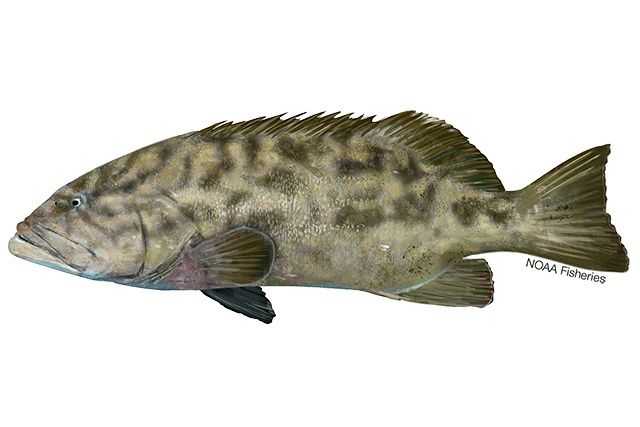Gulf Grouper

Species Details
Mycteroperca Jordani
Serranidae
Perciformes
Nearshore, Offshore, Rocky Reef
72 - 200 lbs.
60" - 78"
Gulf Grouper (Mycteroperca jordani) Fish Description
The Gulf Grouper is a species of fish endemic to Mexico. It belongs to the Serranidae family; its relatives include sea basses (see giant sea bass) and anthias. It highly resembles the broomtail grouper.
The body of the Gulf Grouper is compressed and elongated. Its dorsal fin has 16 to 17 soft rays and 11 spines, whereas its anal fin has 10 to 11 soft rays and 3 spines. Its caudal fin is somewhat concave. Adult Gulf Grouper appear grey or dark brown but they can modify their colors to adjust to their surroundings. Young Gulf Grouper is characterized by the dark grey rectangular markings on the upper part of their fins and bodies.
Diet and Size
The Gulf Groupers are known to feast on lobsters, other fishes, and young hammerhead sharks. They are ambush predators who use their protrusible mouths to suck up their prey. The Gulf Groupers usually hunt between dawn and dusk when their prey is clearly visible.
The Gulf Grouper weighs 70 inches on average and weighs more or less 100 pounds. They can live up to 48 years.
Interesting Facts About the Gulf Grouper
- The male Gulf Grouper are extremely territorial but there have been no reports of sperm competition among them during their spawning season.
- The Gulf Grouper is named after American ichthyologist David Jordan. Oliver Jenkins and Barton Evermann originally named the Gulf Grouper Epinephelus jordani in 1889.
- The Gulf Grouper are protogynous hermaphrodites. Meaning, they generally start as females then later transition to males. This means that reproduction has become even more difficult for this species.
Gulf Grouper — Fishing Techniques
Since this species is considered one of the most valuable groupers, the Gulf Grouper’s population has declined by half over the past eight decades due to overfishing. They are now labeled as Endangered under the IUCN Red List.
Commercial and recreational anglers love to fish Gulf Grouper off the Gulf of California. Since these fish are predictable and gather in large schools, they can easily be captured by fishermen. Usually, the Gulf Grouper are bycatch of shrimp trawls.
Most anglers who want to fish for groupers in general use the bottom fishing method. However, using the live bait rig approach is considered a lot more effective by some experts. This means using a sliding egg sinker on the line above the five- or six-feet long leader. A size-8 or -9 circle hook may be used. The bottom rigs have monofilament leaders (the best material is fluorocarbon).
Some anglers also use trolling when catching groupers. For example, some anglers use magnum diving plus; these devices go as deep as 30 feet or more. This method works well when the water is shallow. The second trolling variation is utilizing a trolling feather and trolling weight. Baits are attached to the double hooked feather with a six-foot leader tied to the one-pound trolling weight which is then attached to the wireline.
Habitat and Distribution
The Gulf Grouper prefer to stay in kelp beds, seamounts, and over rocky reefs. They thrive in depths measuring 16 to 98 feet but can live in areas as deep as 148 feet during summer, and 330 feet on reefs. The juvenile Gulf Grouper prefer to inhabit bays, mangroves, and estuaries around the coastlines of the Gulf of California.
Reports from the 1940s and 1950s showed that the Gulf Grouper have been sighted off San Diego. Generally, the Gulf Grouper thrive in the eastern Pacific Ocean. They are native and endemic to Mexican waters from San Carlos, Baja California Sur to Mazatlán. They are also located in the Revillagigedos Islands and the Gulf of California.






